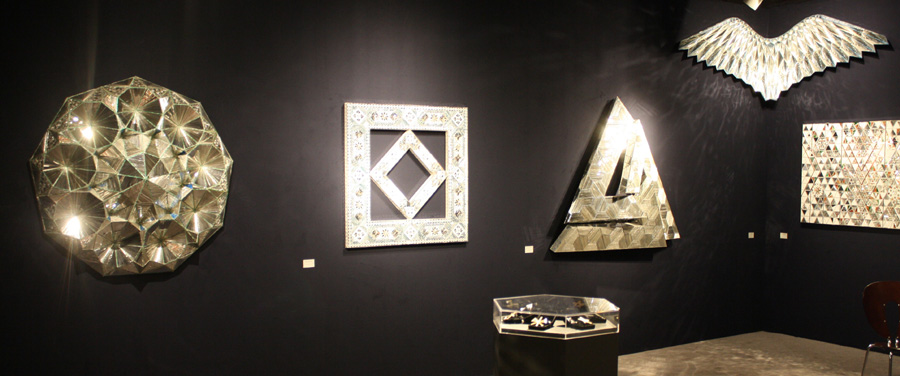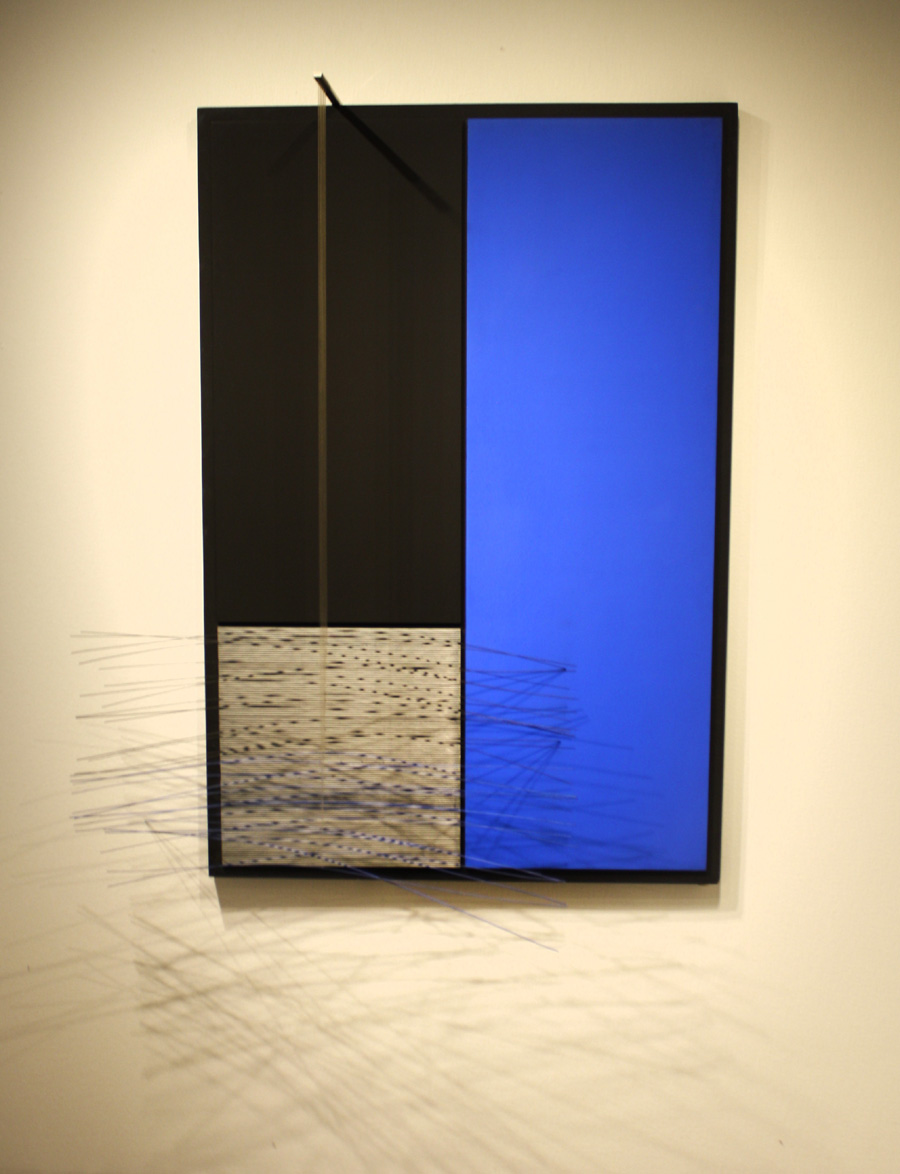Review by Carol Sims, Photos by Greg Smith and Carol Sims.
NEW YORK CITY — The Big Apple was definitely the center of the art world from March 2 to 6 for what has been nicknamed Armory Week, anchored by The Armory Show on Piers 92 (Modern) and 94 (contemporary). Tens of thousands of artworks were shown throughout the city at various venues. Antiques and The Arts Weekly presents the two “sister” shows that form the foundation of Armory Week — The Art Show and The Armory Show.
The Art Show
Starting with Tuesday night’s opening on March 1, The Art Show at the Park Avenue Armory at 67th Street was a good place to get your toe wet before diving in to the rest of the week. Ensconced amid real neighborhoods, the venue is comfortingly familiar to locals and out-of-towners, and the quiet, cavernous armory with its carpeted floors and low lighting gave the art a museum aura. Choice offerings from just 70 dealers were easily digestible and this was the most elegant of all the week’s shows. It is also the longest running art fair in the country. Voices were lower, the pace relaxed, and the dealers knowledgeable — no surprise since they are all members of the Art Dealers Association of America.
International offerings were mostly postwar and contemporary, with several dealers showcasing a single artist. Thomas Colville’s booth with Nineteenth and early Twentieth Century paintings was almost an anomaly, but he assured Antiques and The Arts Weekly that his neighbors made him feel welcome, and he sold a striking Rockwell Kent landscape right off the bat.

Debra Force Fine Art, New York City, was pleased to bring Modernist works, including pieces by Stuart Davis and Charles Burchfield.
According to show promoters, Tuesday’s gala raised $1.1 million for Henry Street Settlement and was attended by 2,750 people. About 15,000 visitors came to the show during its run. Sales were abundant: 303 Gallery sold out its presentation of multimedia works by rising New York-based artist Nick Mauss; Tilton Gallery sold out its debut presentation of new sculptures by Chicago-based artist Simone Leigh; Lehmann Maupin sold nearly all of the works in its solo presentation of recent paintings by Hernan Bas; Salon 94 sold a number of rarely seen early works by Marilyn Minter; David Zwirner sold nearly all of its presentation of Sherrie Levine’s new knot paintings; and Anthony Meier Fine Arts sold a number of Jasmin Sian’s new cutouts.
For additional information, www.theartshow.com.
Gallery
Pier 92
Most folks enter The Armory Show through Pier 94, which is the larger of the two piers. This seems like a good strategy, because tackling the larger pier while one is fresh makes sense. Then after having their eyes filled with the latest art, often by unknown artists brought from emerging galleries, visitors make their way up to Pier 92 by elevator, escalator, or the enormous connecting stairway. Antiques and The Arts Weekly noted that the VIP crowd slowly filtered upward over the course of Wednesday afternoon on March 2.
The first impression of the Modern section is that the display spaces seemed bigger and more luxurious than the ones downstairs. Fifty-six galleries took expansive, airy stands with works from the 1940s, 50s, and 60s up to the present day. While there were plenty of great artworks from the Twentieth Century, including Warhol, Calder, Indiana, Lichtenstein, Chamberlain, Twombly, Ruscha, Botero, Miro, Picasso and many others, not all works were from the secondary market, so the distinction between the piers was a bit blurred, not only aesthetically, but historically, making Pier 92 a bit of a catch-all.
A gorgeous and subtle still life of bottles done in 1950 by European Modernist Giorgio Morandi (1890–1964) from Galleria d’Arte Maggiore, Bologna and Paris, was on one end of the spectrum, Susan Sheehan’s booth full of bright midcentury American artists like Warhol was in the middle and Bryce Wolkowitz Gallery of New York City with sophisticated programmed LED works by MIT graduate Jim Campbell (b 1956) was at the other end. Is Campbell a Modern master? He certainly is a master, with works in the Metropolitan Museum of Art, MoMA, the Smithsonian American Art Museum and the Whitney.

Jonathan Boos, New York City, brought a monumental masterwork by Gary Erbe (b 1944) to Pier 92 “Take Five,” painted in 1982, celebrates the artist’s love of jazz.
Immediately on the right upon entering Pier 92 was the re-created Majorcan studio of Joan Miro presented by Mayoral Galeria d’Art, London. It was inspiring to see Miro’s works displayed in the warm studio atmosphere and not on sterile white gallery walls. The space was inviting and beckoned visitors to slow down and look, as well as to imagine Miro’s creative process.
Hollis Taggart, New York City, brought a delightful and important abstract painting by Hans Hoffmann (1880–1966) entitled “Botanical Garden.” He also brought an enormous Norman Bluhm (1921–1999) painting, an early Calder mobile, a direct-carved tall marble sculpture by Pablo Atchugarry (b 1954) done in 2014 and a vibrant Helen Frankenthaler painting done in 1982. Frank Stella’s 1992 colorfully painted and flamboyantly constructed aluminum wall maquette was given a place of prominence at the Taggart stand.
This may have been the first major art fair that showed “Outsider” art in the same context as all other art — shopped by the same collectors and reviewed by the same critics as “mainstream” art, if there is such a thing. This democratization was especially visible on Pier 92, where Carl Hammer Gallery showed works by Henry Darger, Donald Ellis showed historic paintings by anonymous Native Americans, Andrew Edlin featured Ralph Fasanella and others and Fleisher Ollman brought pieces by James Castle, William Edmondson, Bill Traylor and Martin Ramirez among others. Not only did these gallerists’ displays hold up under scrutiny, they proved to be extremely popular.
Gallery
Pier 94
Most serious buyers shopped Pier 94 on Wednesday, March 2, during VIP day. Later, when the show opened to the public on Thursday, navigating the aisles became much more difficult as the remaining cognoscenti of the city and its environs descended on the shipping terminals in droves. High ceilings and abundant natural light kept the show feeling bright and upbeat.

“This week, New York is sparkling,” said Benjamin Genocchio, director of The Armory Show, at a press conference on Wednesday, March 1. He emphasized that The Armory Show is not a “franchise” fair.
Pier 94 was where The Armory Show presented “Focus: African Perspectives,” a group of international galleries co-curated by Julia Grosse and Yvette Mutumba. This part of the show was well-received by critics and patrons alike and while the theme was apparent in the 14 gallery presentations, it enhanced rather than subsumed the appreciation of the art itself. The Armory Show is part of a growing trend: contemporary African art is on the Bonhams May 2016 auction schedule, and more and more wealthy collectors are developing an appreciation for contemporary art coming from the continent.
Blank, a gallery from Cape Town, South Africa, displayed wall art from Turiya Magadlela, who constructed a large abstraction from orange, red and shocking pink pantyhose stitched together. Whatiftheworld, also of Cape Town, showed Zimbabwe-born artist Dan Halter’s 2015 “Patterns of Migration,” a figure clad in plaid pants with three tartan fabric boxes in place of the top half of the body.
“Armory Presents” was a portion of Pier 94 devoted to 22 emerging galleries less than ten years old. Hundreds of applicants vied for those spots. One of the standouts was Daniel Faria Gallery of Toronto, whose booth featured Douglas Coupland. Black and white images of men and women had their faces obscured by blocks of primary colors and black and white striped rectangles. It is as if the subjects’ identities had been taken over by Modernist avatars. The artist calls these images “Deep Face,” a reaction to Facebook’s initiative to identify all faces posted to the website using facial recognition technology. Coupland’s “Trash Vortex” series is comprised of globes dripped over with colored paints from the location of the Pacific Gyre, the gigantic mass of plastic trash floating in the ocean.

Galerie Thomas Schulte, Berlin, featured Allan McCollum’s “The Shapes Project/Shapes Spinoff” 2005/2016, groups of six unique works, ash, hand lathed.
With the proliferation of contemporary art museums (according to a report from ArtPrice.com, more museums were built between 2000 and 2014 than in the Nineteenth and Twentieth Centuries), the many homes of the wealthy that need art, and the social and financial rewards of collecting, it is no wonder that there are now 180 art fairs worldwide. However, the contemporary art market is deepest and strongest with American collectors, which is one of the reasons international galleries from 36 countries were eager to participate in The Armory Show. The sheer number of artists, galleries, auction houses and cultural institutions that call New York home give the show a critical mass.
The Armory Show is poised to go to new heights under the direction of Benjamin Genocchio, who took over for Noah Horowitz when Horowitz was tapped for Art Basel Miami Beach. Next year will be Genocchio’s first start-to-finish fair, and he plans on making it as collector-friendly as possible. This year he instituted a $1,000 per hour private viewing room for collectors to have a little peace and quiet when evaluating purchases.
For additional information, www.thearmoryshow.com.
Gallery
So Much To See…
A few of the events that took place during Armory Week:
- Art on Paper, 65 international galleries, Pier 36, 299 South Street; March 3–6.
- Clio Art Fair, artists without gallery representation, 508 West 26th Street; March 3–6.
- Independent, 44 galleries, Spring Studios, 50 Varick Street in TriBeCa, March 3–6.
- Moving Image New York, galleries and non-commercial spaces showed single-channel videos and projections, video sculptures and video installations, Waterfront New York Tunnel, 269 11th Avenue at West 27th Street; March 3–6
- Pulse New York, 45 galleries, Metropolitan Pavilion, 125 West 18th Street; March 3–6.
- Scope, 60 galleries, Metropolitan Pavilion West, 639 West 46th Street across from the piers; March 3–6.
- Spring/Break Art Show, a themed fair curated by more than 100 curators focused on 800 emerging artists in New York, Skylight at Moynihan Station on Eighth Avenue across from Pennsylvania station; March 2–7.
- The Armory Show, the main draw, 205 galleries from 36 countries displayed contemporary (Pier 94) and Modern masters (Pier 92); March 3–6.
- The Art Show, longest running art fair in the country, 70 dealers who are members of the Art Dealers Association of America showed American and international works from the Nineteenth Century to the present, Park Avenue Armory at East 67th Street; March 2–6.
- Volta, single-artist project presentations by 100 international, invited galleries, Pier 90; March 2–6.



















